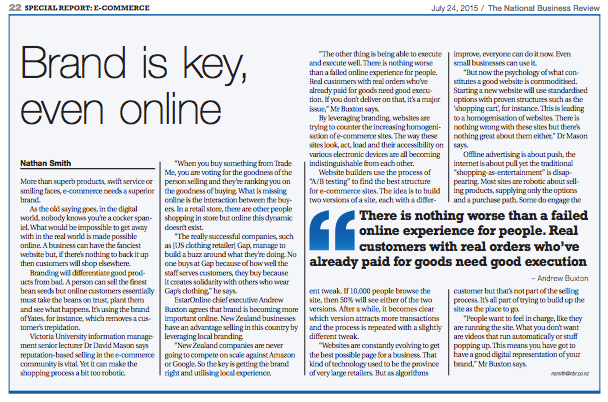
Andrew Buxton - eStar Chief Executive (above) speaks to NBR about why brand is becoming more important online.
First Published in NBR 24 July, 2015
Nathan Smith
Brand is key, even online
More than superb products, swift service or smiling faces, e-commerce needs a superior brand.
As the old saying goes, in the digital world, nobody knows you’re a cocker spaniel. What would be impossible to get away with in the real world is made possible online. A business can have the fanciest website but, if there’s nothing to back it up then customers will shop elsewhere.
Branding will differentiate good products from bad. A person can sell the finest bean seeds but online customers essentially must take the beans on trust, plant them and see what happens. It’s using the brand of Yates, for instance, which removes a customer’s trepidation.
Victoria University information management senior lecturer Dr David Mason says reputation-based selling in the e-commerce community is vital. Yet it can make the shopping process a bit too robotic.
“When you buy something from Trade Me, you are voting for the goodness of the person selling and they’re ranking you on the goodness of buying. What is missing online is the interaction between the buyers. In a retail store, there are other people shopping in store but online this dynamic doesn’t exist.
“The really successful companies, such as [US clothing retailer] Gap, manage to build a buzz around what they’re doing. No one buys at Gap because of how well the staff serves customers, they buy because it creates solidarity with others who wear Gap’s clothing,” he says.
eStar chief executive Andrew Buxton agrees that brand is becoming more important online. New Zealand businesses have an advantage selling in this country by leveraging local branding.
“New Zealand companies are never going to compete on scale against Amazon or Google. So the key is getting the brand right and utilising local experience.
“The other thing is being able to execute and execute well. There is nothing worse than a failed online experience for people. Real customers with real orders who’ve already paid for goods need good execution. If you don’t deliver on that, it’s a major issue,” Mr Buxton says.
By leveraging branding, websites are trying to counter the increasing homogenisation of e-commerce sites. The way these sites look, act, load and their accessibility on various electronic devices are all becoming indistinguishable from each other.
Website builders use the process of “A/B testing” to find the best structure for e-commerce sites. The idea is to build two versions of a site, each with a different tweak. If 10,000 people browse the site, then 50% will see either of the two versions. After a while, it becomes clear which version attracts more transactions and the process is repeated with a slightly different tweak.
“Websites are constantly evolving to get the best possible page for a business. That kind of technology used to be the province of very large retailers. But as algorithms improve, everyone can do it now. Even small businesses can use it.
“But now the psychology of what constitutes a good website is commoditised. Starting a new website will use standardised options with proven structures such as the ‘shopping cart’, for instance. This is leading to a homogenisation of websites. There is nothing wrong with these sites but there’s nothing great about them either,” Dr Mason says.
Offline advertising is about push, the internet is about pull yet the traditional “shopping-as-entertainment” is disappearing. Most sites are robotic about selling products, supplying only the options and a purchase path. Some do engage the customer but that’s not part of the selling process. It’s all part of trying to build up the site as the place to go.
“People want to feel in charge, like they are running the site. What you don’t want are videos that run automatically or stuff popping up. This means you have got to have a good digital representation of your brand,” Mr Buxton says.



0 Comments